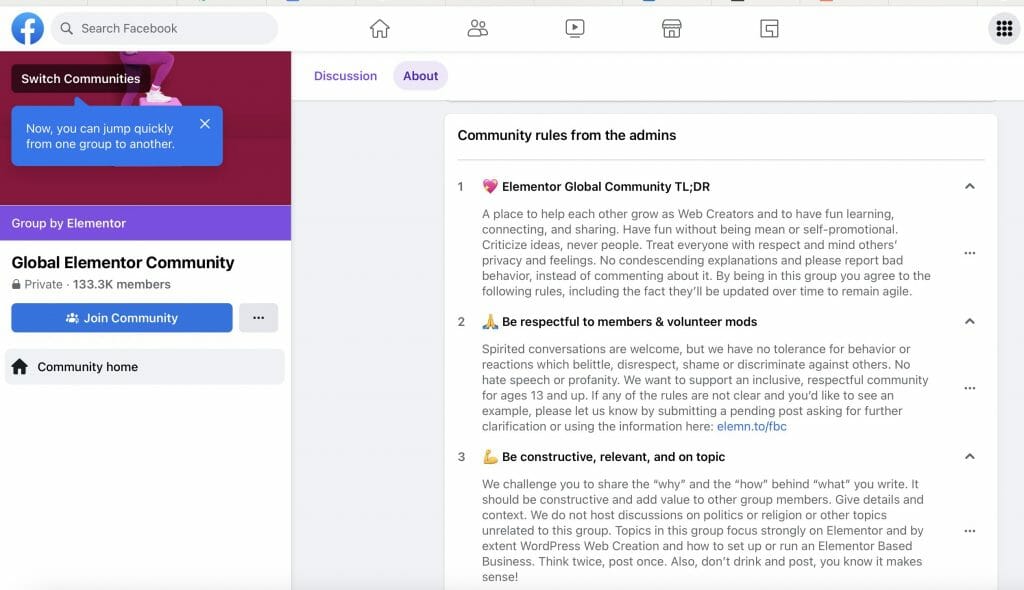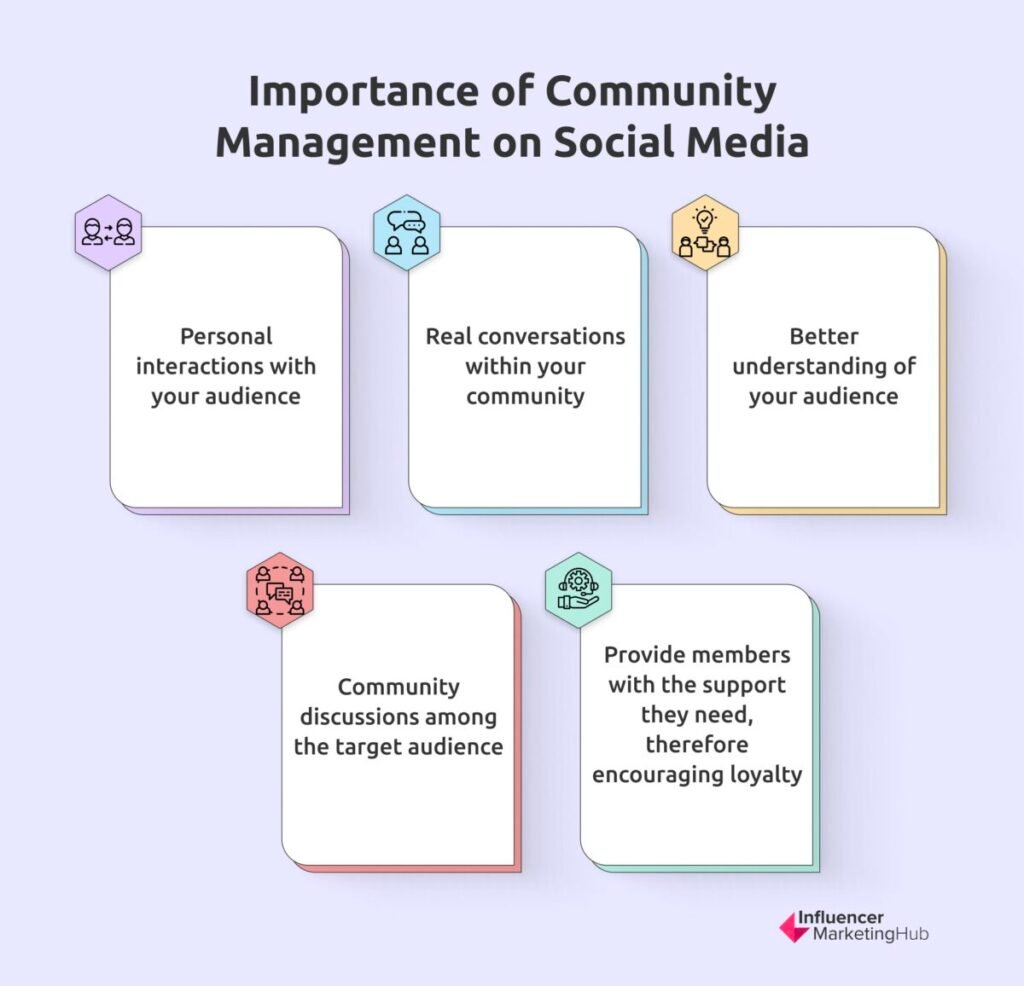At a time when almost every brand has a social media presence, being present on social media alone is no longer enough. For your brand to stand out and build authentic relationships with your audience, you need to build a strong community of followers. Your followers should feel like they’re a part of something, where they can connect with like-minded folks and form a personal bond with your brand.
This is exactly why community management on social media is so important. Investing in it can bring out the humanness of your brand and help you forge a strong connection with your followers. In this guide, we take a deep dive into what community management is on social media and how you can develop effective community management strategies.
What is Social Media Community Management?
Social media community management refers to the process of building a strong community of followers made up of customers, employees, and partners using social media. This would require listening to your audience, responding to them, and creating conversation opportunities to drive more engagement.
It’s more than just posting on social media and expecting fans to engage rather, it’s about actively interacting with your audience to encourage more engagement. This enables you to create a network in which your audience can connect with your brand and others who share similar interests, thus creating a loyal and engaged fanbase.
Community management sometimes involves working with a social media community manager (or multiple) who encourages authentic and consistent interactions among your audience. Here, the community manager will participate in conversations surrounding your brand but using their own account.
what a fun easter egg! discord is now in the new animal crossing update ? https://t.co/bwAbb8tDNj
— Mallory Loar (@MalloryLoar) November 4, 2021
Social Media Community Manager vs. Social Media Manager
Keep in mind that a social media community manager is not to be confused with a social media manager. Your brand’s social media manager will handle your brand’s social media accounts and create posts as your brand. This also means that they have to maintain your brand’s voice and follow your brand’s social media strategy.
Good morning and happy Bank Holiday Monday! How are you spending your day? We'll be here 'til 11:30pm to answer all your queries. Jennifer
— Sainsbury's (@sainsburys) August 29, 2022
Meanwhile, a social media community manager posts as a regular user and encourages engagement among your audience. They participate in discussions within the community and sometimes offer suggestions and support. Since they’re posting as themselves, it gives them the freedom to use their own authentic voice when interacting with others. Think of them as brand ambassadors that independently engage with your community in favor of your brand.
Not all brands have a dedicated social media community manager to engage their communities. However, it helps when you can have a member of the community participate in discussions and encourage more positive engagement. Consider activating influencers and brand ambassadors to drive these conversations and strengthen your brand community. Moreover, your employees can also encourage those conversations and bring out the human face behind your brand.
Importance of Community Management on Social Media
So, why is community management so critical? If you’re already posting regularly on social media, why do you need to manage your community? Here are a few ways your brand can benefit from community management:
- Personal interactions allow you to form a closer relationship with your audience. Responding to their comments, answering their questions, and acknowledging their feedback is effective for developing interpersonal relationships that could evolve into brand loyalty.
- Real conversations within your community could be a great source of feedback and ideas to improve your strategies and products. People may be discussing their negative experiences and sharing their opinions on what could be improved, which you can then use to inform your product development and customer support teams.
- Similarly, those conversations could also give you a better understanding of your audience. Based on the discussions, you could get an idea of what they want and expect from your brand, even if it’s not a downright complaint.
For example, the following comments on the Whataburger Facebook post reveal that many of their customers want the brand to bring back the jalapeno cheddar biscuit. A community manager monitoring and engaging with those comments could suggest what menu additions should be made.

Source: facebook.com
- Some of the community discussions could also boost brand and product awareness among the target audience. When people see how others talk about a certain product or service they’ve never heard of or used before, it could inform their buying decisions. Based on those conversations, they might even get enticed to try the product or service themselves.
- Community management is crucial for providing your customers or members with the support they need. Even if it’s something seemingly minor, quickly responding with a solution is a great way to show how responsive and helpful your brand is. This could then encourage more fan loyalty and even drive others closer to a purchase. For example, Ulta Beauty quickly responds to customer questions on Instagram and helps them find the answers they need.
6 Community Management Strategies to Get Started
Now that we’ve established why you should invest in social media community management, it’s time to move on to the more practical aspects. Check out these six community management strategies to help you activate and engage your community on social media.
1. Clearly Define Rules and Guidelines to Follow
Your community should be a place for people to belong and be themselves. However, that doesn’t mean you turn it into a social media “wild west” where anyone can do whatever they please even if it means hurting other community members. Moreover, you’d want the community to accurately represent your brand and the values it upholds.
This makes it crucial to start with a set of rules and guidelines that community members must abide by to create a safe and welcoming place for everyone. These rules and guidelines should also be upheld by contributors and team members who are in charge of managing your community. The specifics may vary depending on the type of community you’ve set up, but you’d typically want your guidelines to cover the following:
- Clearly specify how members are expected to communicate and behave within the community. This includes listing the type of language or behavior that’s in violation of the rules such as using racist and discriminatory language or stalking other members. Additionally, you could also include rules about how members are expected to contribute to the community. For example, by keeping feedback more constructive than critical.
- The rules and guidelines should be documented and shared with new members as they join. It could even be pinned to your page (if the platform allows it) for easy reference.
- Set up a process for escalating major issues by specifying who should handle those cases and how they should be managed.
For example, see how the Global Elementor Community on Facebook has a set of community rules added to their “About” page. These rules clearly explain what the community should be about, how people should be respectful to other members and volunteer mods, and so on.

Source: facebook.com
2. Be Consistent and Present
Consistency is key when it comes to building an engaged community. The whole point of managing a community is to forge connections and nurture communication. By belonging to your community, people should be able to have their questions answered, get the support they need, and feel a sense of belonging through those interactions.
So, make sure to be active and present for your community. Consistently check on the conversations and respond when appropriate. If necessary, regularly create engagement opportunities by asking questions, sharing prompts, and providing updates.
3. Listen to Your Community
In order for your community management efforts to work, the interactions within your community should be thoughtful and meaningful. Your responses and posts should be relevant to what your members want and need from you. This makes it crucial to closely listen to what members have to say. That way, you can get a better understanding of how to respond and provide appropriate solutions.
Take a look at how Trupanion responded to comments on WeRateDogs’s Twitter post talking about their partnership. The post featured a dog named Gill who seemed pretty happy playing with balls. Trupanion acknowledged comments from people who shared pictures of their own dogs while also providing reliable answers to serious questions.
These types of meaningful interactions can help you nurture your relationship with community members. They also show that you’re listening to your audience and that you care about what they have to say.
This is Gill. He says "insurance reimbursement" is a mouthful, and he's an expert on mouthfuls. Has @Trupanion insurance so his vet hospital can be paid directly, which is easy peasy. 13/10 #partner pic.twitter.com/6t9vebWjcT
— WeRateDogs® (@dog_rates) July 26, 2022
Moreover, listening to your community could also help you uncover insights about your audience that are not available anywhere else. Since your brand community gives them the perfect channel to express themselves, it serves as a great source of information on your audience’s needs, concerns, and pain points. You can then use these insights to inform different aspects of your business–from product development to customer support.
4. Activate Influencers and Brand Ambassadors
One of the reasons why people want to belong to a community is the chance to have real conversations with real people. In certain situations, they might feel much more inclined to engage with other regular social media users than with your brand. For example, they may seek purchase recommendations based on experiences and reviews of real customers who have used the product before.
This is why working with influencers and brand ambassadors could help further your community management efforts. These users could encourage more engagement within your community by sharing their thoughts and experiences or even asking relevant questions. Some can even answer questions related to your brand or products and services and guide your target audience toward a purchase decision.
Since these interactions come from real people, they may be considered as more authentic and relatable compared to replies coming from your brand. Here’s a great example with an influencer sharing an Instagram Reel where she used the Wax Kit from Billie. The influencer not only acknowledged followers who remarked how easy it looked but also answered questions about how well the product worked for specific body parts.
5. Encourage Employee Participation
Your employees could also make a great addition to your community management strategy. They serve as a reliable source of information because who knows your company better than the ones inside? Plus, the fact that their interactions will come from their own accounts adds a layer of humanness and authenticity.
So, make sure to encourage your employees to engage with community members. They could do this by answering questions and acknowledging responses. Additionally, they could even help you expand your community by sharing news, updates, and experiences within their own networks.
For example, you could get employees to talk about the culture and experience working at your company while sharing news about relevant job openings. That’s exactly what the following community program manager did when sharing news about open positions at OpenSpace. This adds to the authenticity and appeal of the job opening since an actual employee is talking about how great it is to work at the company.
6. Determine How to Measure Success
Finally, make sure you have clarity on what success looks like to you. Just like your other brand growth strategies, your community management strategies should also help you achieve a specific goal. Although the goal may not be as measurable as your marketing strategy or ad campaign, it should still be specified.
For example, you may be working to increase participation in your live chat conversations or discussions. Or you may want to build a larger community by increasing your follower count. Whatever the goal is, make sure to clearly determine how to measure the success of your community management efforts.
Build a Thriving Community
Social media community management is no walk in the park. It requires you to pay close attention and drive meaningful conversations among your audience. So, consider naming official social media community managers who can help you build an engaged and loyal community.
Frequently Asked Questions
Why is social media community management important?
Social media community management helps you drive authentic engagement and build a loyal community of followers.
What makes a good social media community manager?
A good social media community manager pays close attention to conversations and provides meaningful responses in an authentic manner. They’re also digitally savvy and are aware of current social media trends that could influence audience behavior and opinions.
What is a social media community?
A social media community refers to spaces within social media where people come together to connect with like-minded individuals and share their thoughts and experiences.
How do you build a social media community?
You build a social media community by consistently producing content that your audience is interested in and driving meaningful interactions.
What is effective community management?
Effective community management involves closely listening to your audience’s conversations and responding in a timely and relevant manner. It also involves providing engagement opportunities by asking relevant questions and encouraging participation from community members.




